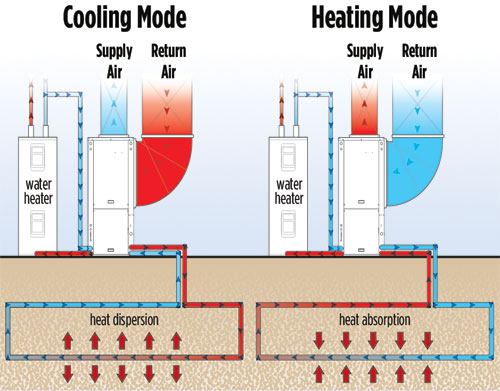Home heat pumps

Image Credit: WFI Industries
One of the most overlooked and effective geothermal technologies is the heat pump. As shown in the diagram above, the technology can be used for heating and cooling and depending on the annual temperature variance from the base earth temperature, annual savings vs. conventional HVAC equipment can be as high as 50% per year. Essentially, these systems use the earth (or water held in the earth) as a heat exchanger, moving heat from one place to another via a working fluid in a closed loop system.
In a heating situation, if the ambient air temperature is 32F (0C) and the earth temperature is 53F (12C) the working fluid will be used to transfer heat from the earth to the interior ambient environment – a 21F (12C) advantage over taking exterior ambient air – and then will use conventional means to heat the air to the desired temperature. In a cooling situation, it’s the reverse taking heat from the interior ambient air and transferring it to the earth. Since most humans don’t wish to live in 53F temperatures, further cooling isn’t generally necessary.
One of the leaders in geothermal heat pumps is Indiana based WFI Industries, manufacturer of the Water Furnace. It would seem over the past few years that WFI has been discovered, take a look at their stock chart from that time frame:

Image Credit: Yahoo Finance
This is clearly a technology with huge benefits, particularly where the climate has significant differences in ambient air temperature between summer and winter conditions.









This technology is starting to take off in Southern Ontario area. Can you explain what you are doing to educate North America about its payback as Europeans seem to have adopted it in a greater scope. What is payback in an intial installation and replacement of conventional forced air. Thank You.
Thanks for the comment Howard. The answer to the cost question isn’t generic, the WFI website claims a conventional HVAC system cost is $4500 and a Heatpump system is $7000. Whatever is being paid for heating/cooling, take 25-50% of that cost per year out and apply it to the heat pump. Again, WFI claims a conservative estimate is a 6 year payback.
As for what we’re doing to educate North America, we’re writing entries like these and answering comments like yours!
Thanks for your quick reply. This demonstrates genuine interest in investor and consumer research. Your right, my question was generic considering your scope of business. Wat square footage of service was your dollar value relevant to. Thank You, again.
One of the biggest hurdles in home energy efficiency is the relatively short span of expected occupancy in any given home. The thought of “yea, but I might move in the next few years” stymies many good investments. This will become much less of a problem when home buyers look at life cycle energy costs more seriously but we are not there yet as a society, at least we’re not on the west coast of the US where I’m most familiar.
Bill
You’re right Bill, on the West Coast in particular where people are pretty mobile and the weather is temperate. But I wonder if the interior of the country where those two things are not true might be a little different?